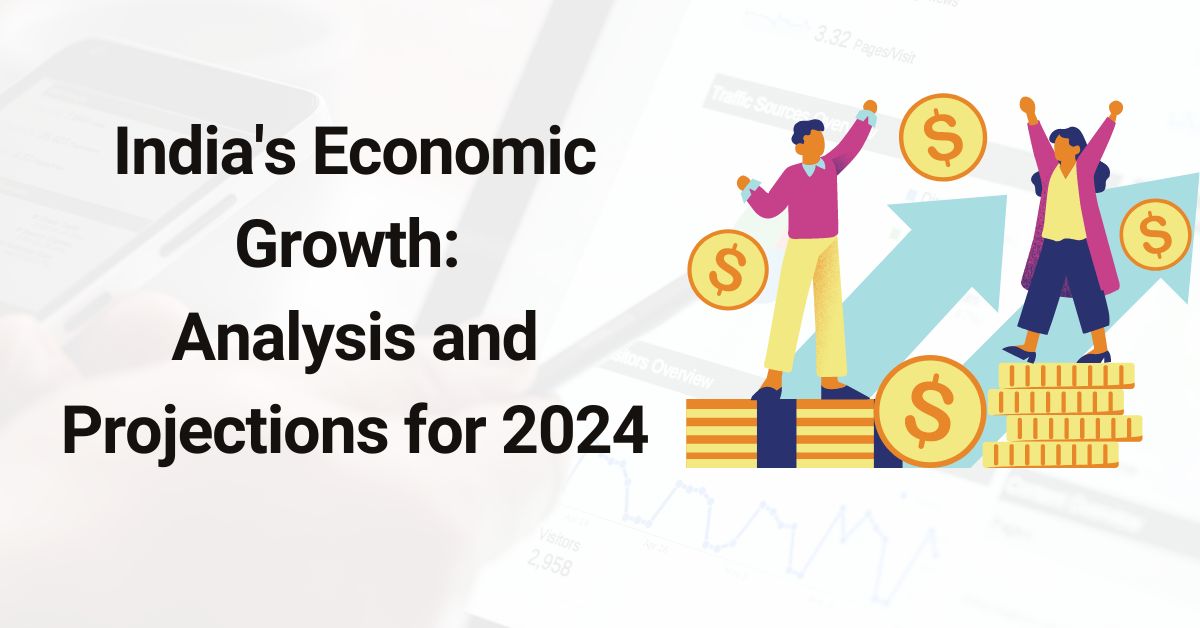India’s Economic Growth – India की economy को January-March quarter of 2024 में काफी slowdown face करना पड़ा, जो पिछले एक साल में सबसे slowest pace था। इस period में देश का gross domestic product (GDP) annual basis पर 6.7% बढ़ा।
यह deceleration India की long-term GDP growth rate के ज्यादा करीब है, जो एक ज्यादा stable लेकिन moderated economic environment को reflect करता है, compared to पिछले quarter के unexpected 8.4% growth के।

Quarterly GDP और GVA Trends
पिछले quarter की GDP surge काफी हद तक subsidies में sharp reduction के कारण थी, जिसने artificially net indirect taxes को boost किया था। हालांकि, economic activity का ज्यादा सही metric, gross value added (GVA), ने 6.5% की ज्यादा modest expansion दिखाई।
January-March quarter के लिए, GVA growth के और slowdown होकर 6.2% पर आने की उम्मीद थी, जो various sectors में broader deceleration को indicate करता है।
Sectoral Analysis: Manufacturing, Services, और Agriculture
Manufacturing Sector
Manufacturing sector, जो India के GDP का crucial component है, ने slowdown के signs दिखाए। इस sector में moderation के कई factors हो सकते हैं, जैसे global economic uncertainties, supply chain disruptions, और fluctuating demand।
इन challenges के कारण industrial output subdued रहा, जिसने overall economic growth को impact किया।
Services Sector
Services sector, जो India के economic expansion का significant driver रहा है, ने भी slowdown experience किया। Key areas जैसे information technology, financial services, और real estate को reduced consumer spending और investment के कारण headwinds का सामना करना पड़ा।
इस sector का performance critical है क्योंकि यह GDP और employment का substantial portion constitute करता है।
Agricultural Sector
Agriculture, जो India की economy का vital part है, ने January-March quarter में growth में muted contribution दिखाया। Factors जैसे erratic weather patterns, lower crop yields, और insufficient support prices ने collectively agricultural output को hinder किया।
इस sector की stagnation rural incomes और overall economic stability के लिए challenges pose करती है।
Consumption Patterns और Core Inflation
Private consumption, जो India के GDP का 60% account करता है, ने quarter के दौरान weaker growth exhibit की। यह trend declining consumer confidence और purchasing power को indicate करता है।
Additionally, core inflation ने भी drop करना जारी रखा, pandemic के onset के बाद से lowest growth record करते हुए। Domestic demand की persistent weakness economy को higher growth rates sustain करने में faced challenges को underscore करती है।
Economic Forecasts और Future Outlook
GDP Growth Projections
India की economic growth, जो पिछले fiscal year में average 7.7% थी, इस fiscal year में slow होकर 6.8% और अगले fiscal year में और slow होकर 6.6% होने की forecast है।
ये projections consistent 8% growth achieve करने में difficulty को highlight करते हैं, जो annually workforce में enter होने वाले millions of young people के लिए adequate job opportunities generate करने के लिए necessary माना जाता है।
Expert Opinions
Economists की views India की potential growth rate पर vary करती हैं। कुछ, जैसे Pantheon Macroeconomics के Miguel Chanco, suggest करते हैं कि 5-6% growth rate ज्यादा realistic है, जबकि अन्य comprehensive reforms की जरूरत पर जोर देते हैं।
Key agricultural reforms के reversal, new labor codes implement करने में delays, और regional trade agreements की ओर cautious approach को higher growth में impediments के रूप में cite किया गया है।
Government Estimates और Statistical Discrepancies
National Statistical Office (NSO) ने January-March quarter के लिए 5.9% GDP growth rate project की है। इस conservative estimate ने growth measurements की accuracy पर debates spark की हैं, particularly concerning informal sector, जो लगभग आधा GDP contribute करता है और workforce का करीब 90% employ करता है।
Informal sector के data estimation में discrepancies economic performance की overestimations की ओर lead कर सकती हैं, जिससे statistical reports और on-ground realities के बीच disconnect हो सकता है।
Policy Recommendations और Reforms
India की full economic potential unlock करने के लिए कई policy measures और reforms necessary हैं:
Manufacturing को Revitalize करें: Advanced manufacturing technologies और infrastructure development में investments encourage करें ताकि productivity और competitiveness enhance हो सके।
Services Sector को Strengthen करें: Key service industries में innovation और digital transformation promote करें ताकि growth sustain हो और high-value jobs create हों।
Agricultural Development को Support करें: Comprehensive agricultural reforms implement करें ताकि crop yields improve हो, support prices मिलें, और sustainable rural incomes ensure हों।
Domestic Demand को Boost करें: Fiscal और monetary policies initiate करें जो consumer spending बढ़ाने और economy में confidence restore करने की aimed हों।
Structural Reforms को Facilitate करें: Labor codes और trade agreements implement करने में तेजी लाएं ताकि business और investment के लिए conducive environment create हो सके।
ये भी पढ़े:
IndiGo Stock: अनालिसिस और फ्यूचर प्रोस्पेक्ट्स
IGL vs MGL : लॉन्ग-टर्म इन्वेस्टमेंट के लिए 5-पॉइंट एनालिसिस
Conclusion
India की economic growth ने January-March quarter of 2024 में significant challenges face किए, जो broader global और domestic issues को reflect करता है। हालांकि देश के long-term growth prospects promising बने हुए हैं, consistant high growth rates achieve करने के लिए strategic policy interventions और structural reforms जरूरी होंगे।
इन challenges को head-on address करना crucial होगा ताकि India अपने trajectory को sustain कर सके as one of the world’s fastest-growing major economies.
